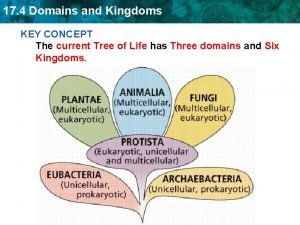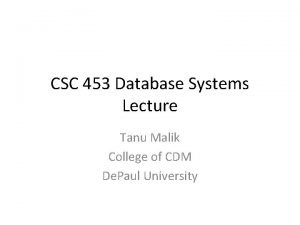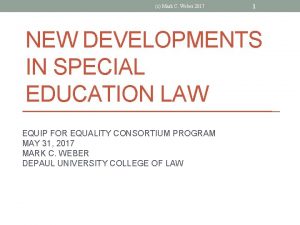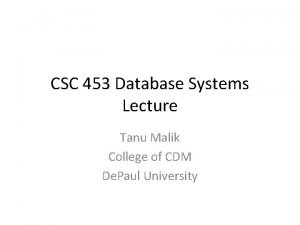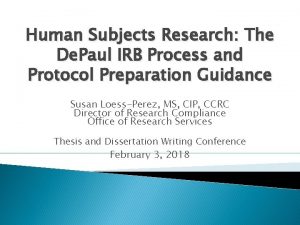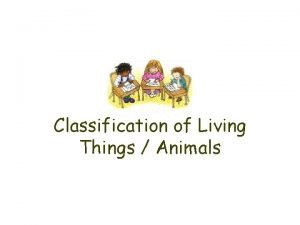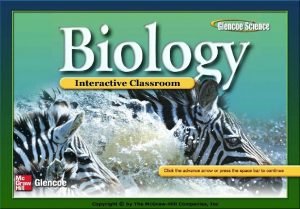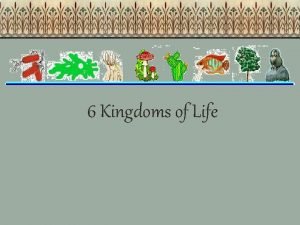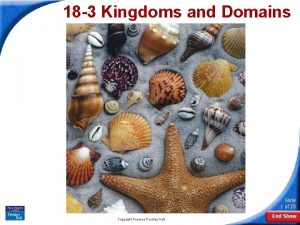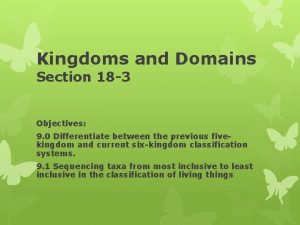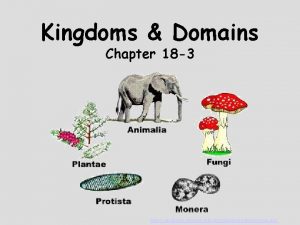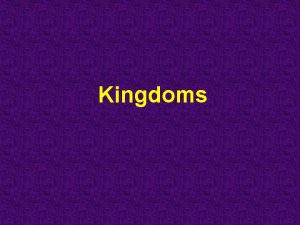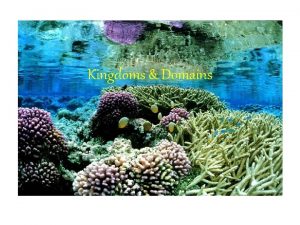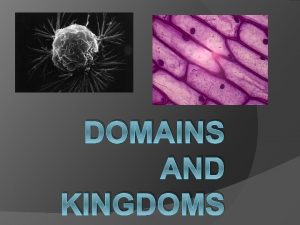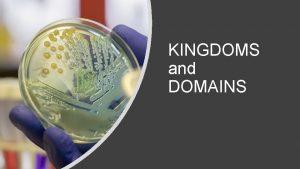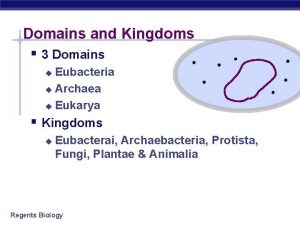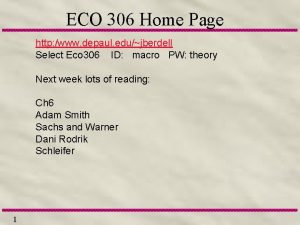Kingdoms Domains Chapter 18 3 http analyzer depaul













- Slides: 13

Kingdoms & Domains Chapter 18 -3 http: //analyzer. depaul. edu/astrobiology/kingdoms. jpg

FIVE ORIGINAL KINGDOMS ____________ (BACTERIA) http: //analyzer. depaul. edu/astrobiology/kingdoms. jpg

As we learned more about bacteria, MONERA kingdom was split the _____ into TWO distinct kingdoms ______ Eubacteria & _______ Archaebacteria 6 KINGDOMS used today Eubacteria Archaebacteria Protista Plantae Fungi Animalia

THREE-DOMAIN system Molecular analyses have given taxonomic rise to a new ______ category _______ now recognized = DOMAIN _______ Domain Bacteria Archaea Eukarya Kingdom Eubacteria Archaebacteria Protista Plantae Fungi Animalia

Cell without a nucleus PROKARYOTE = ______ REMEMBER (Includes bacteria) Cell with a nucleus and organelles surrounded by membranes = _________ EUKARYOTE (includes plants and animals) Organism that can make its own food using photosynthesis or chemosynthesis = AUTOTROPH _______ Organism that gets food energy from consuming other organisms = HETEROTROPH _______

A ONE-CELLED organism UNICELLULAR = ___________ REMEMBER Organism made of many cells MULTICELLULAR = _______ Polysaccharide made by joining glucose molecules together which makes plants sturdy CELLULOSE = _________ http: //bioweb. wku. edu/courses/Biol 115/Wyatt/default. htm

DOMAIN: BACTERIA KINGDOM: EUBACTERIA PROKARYOTES ____________ UNICELLULAR ___________ PEPTIDOGLYCAN Have cell walls with ________ AUTOTROPHS or HETEROTROPHS Can be ______________ E. coli, Streptococcus EXAMPLES: ___________ http: //chemiris. chem. binghamton. edu/ZHONG/research/bacteria 3. jpg

DOMAIN: ARCHAEA KINGDOM: ARCHAEBACTERIA PROKARYOTES _________ UNICELLULAR _________ Have cell walls WITHOUT peptidoglycan _____ AUTOTROPHS HETEROTROPHS Can be ______ or _______ Halophiles; thermophiles; EXAMPLES: ___________ LIVE IN EXTREME ENVIRONMENTS like volcanic hot springs, brine pools, low oxygen

http: //www. teara. govt. nz/NR/rdonlyres/737 B 7002 -C 31 D-418 D-84 C 5 -D 0 E 68 ED 87 BBB/134228/hero 6483. jpg Organisms that can live in HIGH temperature environments THERMOPHILES = ________ Organisms that can live in high salt environments HALOPHILES = _______ http: //web 0. greatbasin. net/~wigand/petespaleo/Columbus%20 Salt%20 Marsh. jpg

DOMAIN: EUKARYA KINGDOM: PLANTAE EUKARYOTES ____________ MULTICELLULAR ___________ CELLULOSE Have cell walls with ________ and CHLOROPLASTS _______ AUTOTROPHS _________ Mosses, ferns, trees, EXAMPLES: ___________ flowering plants http: //www. russianflora. com/store/images/product/custom_green_plant_35. jpg

DOMAIN: EUKARYA KINGDOM: ANIMALIA http: //www. millan. net EUKARYOTES ____________ MULTICELLULAR ___________ NO CELL WALLS or ________ CHLOROPLASTS ________ HETEROTROPHS _________ Worms, insects, fish, birds, EXAMPLES: ___________ mammals, humans

DOMAIN: EUKARYA KINGDOM: FUNGI EUKARYOTES ____________ Most MULTICELLULAR; few UNICELLULAR ___________ CHITIN Have cell walls with ________ HETEROTROPHSabsorb nutrients from decaying _________________ organic matter ____________ EXAMPLES: ___________ Mushrooms, yeast http: //www. ontarionature. org/home/images/mushrooms. jpg

DOMAIN: EUKARYA KINGDOM: PROTISTA (The catch-all group) ____________ EUKARYOTES Most UNICELLULAR; some colonial/multi ___________ Some have cell walls with CELLULOSE ________ Some have chloroplasts __________ AUTOTROPHS or HETEROTROPHS Can be _____________ Amoeba; Paramecium; EXAMPLES: ___________ Giant kelp; slime mold http: //www. ravelgrane. com/pix/proj/draco/paramecium-nahrung. gif
 Chapter 17 section 3 domains and kingdoms
Chapter 17 section 3 domains and kingdoms Concept mapping domains and kingdoms
Concept mapping domains and kingdoms Tanu malik depaul
Tanu malik depaul Mark weber depaul
Mark weber depaul Priya malik and tanu malik
Priya malik and tanu malik Depaul irb
Depaul irb Clark elliott depaul
Clark elliott depaul 6 kingdoms
6 kingdoms Bacteria kingdom characteristics
Bacteria kingdom characteristics I am covered in dry scales and i lay eggs. what am i?
I am covered in dry scales and i lay eggs. what am i? Organizing lifes diversity
Organizing lifes diversity Kingdoms of life chart
Kingdoms of life chart Section 18-3 kingdoms and domains
Section 18-3 kingdoms and domains Section 18-3 kingdoms and domains
Section 18-3 kingdoms and domains

